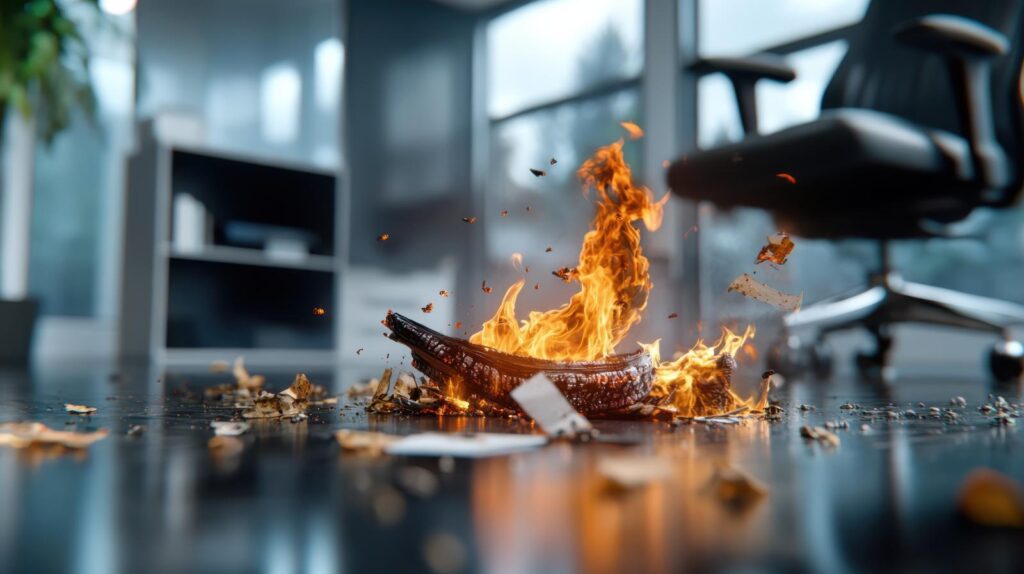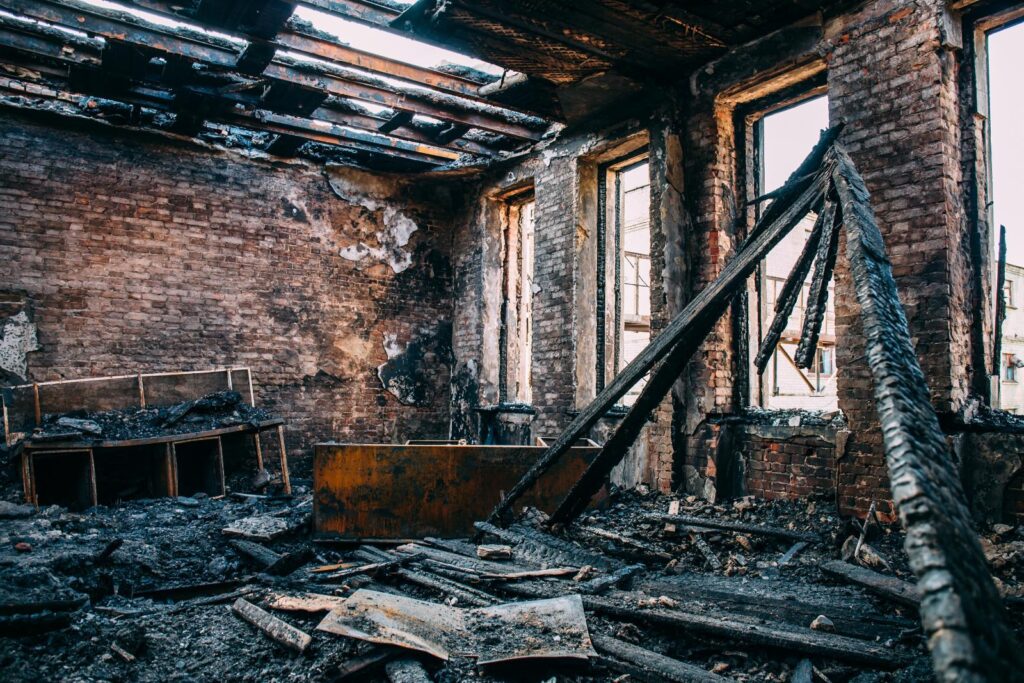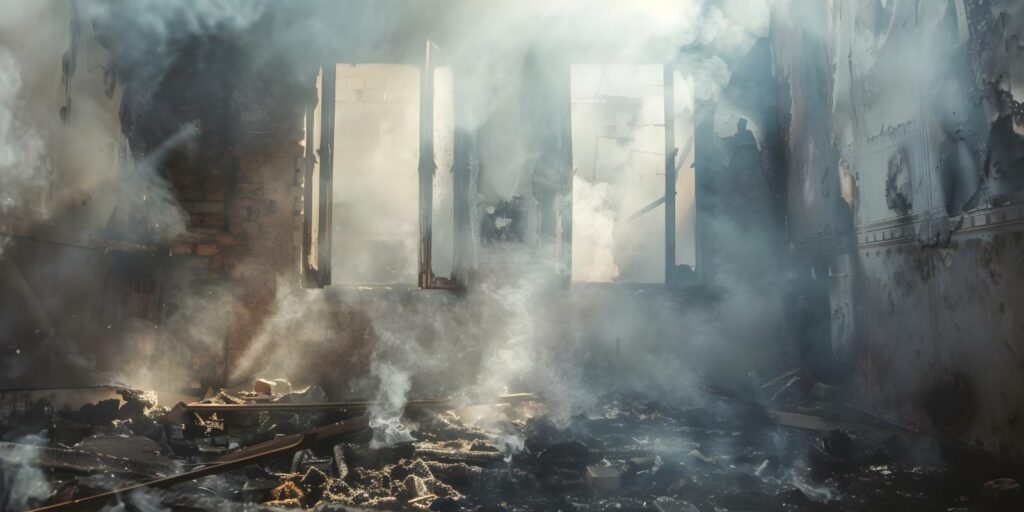
Contents
Imagine standing in the aftermath of a fire, much like surveying a battlefield where everything once vibrant now lies in ashes. You know the importance of swift action, but do you really understand the steps involved in effective fire damage cleanup? From assessing the extent of the damage to navigating insurance claims, each stage requires expertise that can feel overwhelming. As you consider your options, the choices you make now can significantly impact your property’s recovery and safety. What’s the best approach to ensure you’re not just restoring, but truly revitalizing your space?
Key Takeaways
- Conduct a thorough damage assessment to identify affected areas and salvageable items before starting cleanup.
- Prioritize safety by wearing protective gear and ensuring structural integrity before entering the damaged space.
- Document all damage with photos for insurance claims, providing crucial evidence for restoration efforts.
- Remove burnt materials safely and clean surfaces with appropriate cleaners, addressing smoke odors and residues effectively.
- Consult professional fire damage restoration services for comprehensive cleaning, repairs, and restoration of your property.
Understanding Fire Damage
Understanding fire damage is crucial for anyone facing the aftermath of a blaze, whether in a home or business. When you experience a fire, it’s essential to grasp how fire behavior affects the extent of the damage. Fires can spread rapidly, fueled by materials in their path, and understanding this behavior can help you assess potential risks and impacts on your property.
In addition to the flames, smoke types play a significant role in determining the damage you might encounter. Different materials produce different smoke, which can lead to various forms of damage. For instance, synthetic materials create a thick, black smoke that can leave behind heavy soot, while wood burns cleaner, producing a lighter smoke. This distinction is vital because each type of smoke requires specific cleaning methods and materials.
You may also discover that smoke can infiltrate walls, ceilings, and even HVAC systems, complicating the cleanup process. Recognizing how smoke behaves allows you to make informed decisions about restoration, highlighting the importance of professional assistance if the damage is extensive.
Assessing Cleanup Needs
After a fire, assessing cleanup needs is your first step toward recovery and restoration. This crucial process involves a comprehensive damage assessment to identify what’s salvageable and what needs to be removed or replaced.
Start by walking through the affected area, taking notes and photos to document the damage. This will help you to prioritize your cleanup efforts and make informed decisions.
Here are some key areas to consider during your assessment:
Structural Integrity: Check for any damage to walls, ceilings, and flooring.
Fire-Related Residue: Identify areas with soot, smoke, or chemical residues that require special cleaning.
Water Damage: Look for signs of water damage from firefighting efforts, which may lead to mold growth.
Personal Belongings: Sort through items to determine what can be cleaned, restored, or needs to be discarded.
Electrical Systems: Inspect wiring and outlets for any fire-related damage that could pose risks.
Safety Precautions to Consider
Once you’ve assessed the damage, it’s vital to prioritize safety before beginning any cleanup efforts. Fire safety should always be your foremost concern, as the aftermath of a fire can lead to hazardous conditions.
Start by ensuring that the area is structurally sound. If you’re uncertain, it’s best to have a professional evaluate the premises before you step inside.
Personal protection is crucial during this stage. Wear appropriate gear, including gloves, masks, and goggles, to shield yourself from soot, ash, and potentially harmful chemicals. These materials can irritate your skin, eyes, and respiratory system, so don’t take any chances.
Long-sleeved shirts and sturdy boots are also advisable to protect against sharp debris.
Make sure you have a reliable source of light, especially if the power’s out. Flashlights will illuminate dark corners where hazards may lurk.
Also, keep a first-aid kit handy in case of minor injuries.
As you work, stay alert for potential dangers like toxic fumes or unstable structures. If you notice anything concerning, don’t hesitate to step back and reassess the situation.
Remember, rushing in isn’t worth the risk.
Finally, consider enlisting the help of friends or family. They can provide support and additional eyes to ensure safety throughout the cleanup process.
Fire Damage Cleanup Process
The fire damage cleanup process demands careful planning and execution to restore your space effectively. After a fire, it’s crucial to address the aftermath promptly to minimize further damage and ensure your home feels welcoming again.
Begin by assessing the extent of the damage. You’ll want to identify areas affected by heat, smoke, and water used during firefighting efforts.
Next, prioritize safety. Wear protective gear and ensure the structure is stable before entering. Once you’re in, start removing debris and damaged materials to facilitate thorough cleaning and fire damage restoration.
Here’s a quick checklist to guide your cleanup efforts:
- Document the Damage: Take photos for insurance claims.
- Remove Burnt Items: Safely dispose of charred furniture, carpeting, and other belongings.
- Clean Surfaces: Use appropriate cleaners to remove soot and stains from walls and floors.
- Smoke Odor Removal: Employ air purifiers and specialized treatments to eliminate lingering odors.
- Assess and Repair: Look for hidden damage in walls and ceilings that may require professional attention.
As you move through this process, keep in mind that restoring your space isn’t just about cleaning; it’s about reclaiming your comfort and sense of belonging.
Professional Repair Services
Engaging professional repair services is essential for effectively restoring your home after fire damage. These experts play a crucial role in the fire restoration process, ensuring your home is safe and livable again. They provide a thorough damage assessment, identifying structural issues, compromised systems, and areas that need immediate attention.
Here’s a quick overview of the key services offered by professional repair teams:
| Service Type | Description | Importance |
|---|---|---|
| Damage Assessment | Comprehensive evaluation of damage | Ensures all issues are identified |
| Structural Repairs | Fixing walls, roofs, and foundations | Restores safety and stability |
| Electrical Repairs | Replacing damaged wiring and systems | Prevents fire hazards |
| HVAC Restoration | Cleaning and repairing ventilation systems | Ensures clean air circulation |
| Interior Restoration | Replacing drywall, flooring, and fixtures | Restores aesthetic appeal |
When you hire professionals, you’re not only getting skilled labor but also peace of mind. They’ll guide you through each step, from assessing the damage to executing repairs. They understand the emotional weight of fire damage and strive to restore your home to its former glory.
Insurance Claims for Fire Damage
After addressing the immediate repairs needed for your home, navigating the insurance claims process for fire damage becomes a top priority.
Understanding how to effectively work with your fire insurance can make a significant difference in getting your life back on track.
Here’s how you can streamline the claim process and ensure you receive the compensation you deserve.
Document Everything: Take photos and videos of the damage. This evidence is crucial in supporting your claim.
Review Your Policy: Familiarize yourself with the specifics of your fire insurance coverage. Know what’s included and excluded.
Contact Your Insurer Promptly: Don’t delay in notifying your insurance company about the fire. The sooner you reach out, the quicker you can initiate the claim process.
Keep Records: Maintain detailed notes of conversations with your insurer and any expenses incurred due to the fire.
Consult Professionals: Engage with fire damage restoration experts. They can provide assessments that might strengthen your claim.
Preventing Future Incidents
To keep your home safe from fire hazards, it’s crucial to prioritize fire safety education and conduct regular maintenance checks.
Understanding potential risks and knowing how to respond can make all the difference in emergencies.
Fire Safety Education
Understanding fire safety is crucial for preventing future incidents and protecting your home and family. By prioritizing fire prevention and emergency preparedness, you can create a safer environment for everyone.
Here are some key points to keep in mind:
Install smoke detectors: Place them in every room and test them monthly.
Create a fire escape plan: Ensure everyone in your household knows their routes and meeting points.
Practice safe cooking habits: Never leave cooking unattended, and keep flammable items away from heat sources.
Store flammable materials properly: Keep gasoline, paint, and other chemicals in designated areas, away from the home.
Educate your family: Discuss fire safety regularly, so everyone knows the risks and how to respond.
Regular Maintenance Checks
Regular maintenance checks play a vital role in preventing fire incidents and ensuring your home remains safe. By taking the time to inspect your fire alarm systems and smoke detectors regularly, you can catch potential issues before they become serious hazards.
Start by testing your smoke detectors monthly; a simple press of the test button can alert you to any malfunction. Replace the batteries at least once a year or whenever you hear that pesky chirping sound.
Next, check your fire alarms to ensure they’re up to code. Look for signs of wear and tear, and replace any unit that’s over ten years old.
Also, make sure your fire extinguishers are easily accessible, fully charged, and inspected annually.
In addition to these checks, you should also create a fire escape plan with your family. Discuss routes and designate a meeting spot outside your home. This way, everyone knows what to do in case of an emergency.
Wrap-Up
In the aftermath of a fire, your home can feel like a phoenix rising from the ashes. By understanding the cleanup process and seeking professional help, you’re not just restoring your space; you’re reclaiming your peace of mind. Remember, every soot-stained wall tells a story, and with the right services, that story can have a happy ending. Don’t wait—act swiftly, and let the experts guide you in turning devastation into rejuvenation. Your home deserves it.



